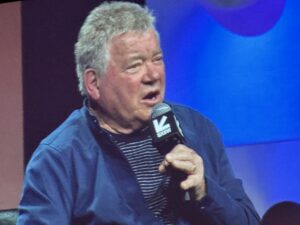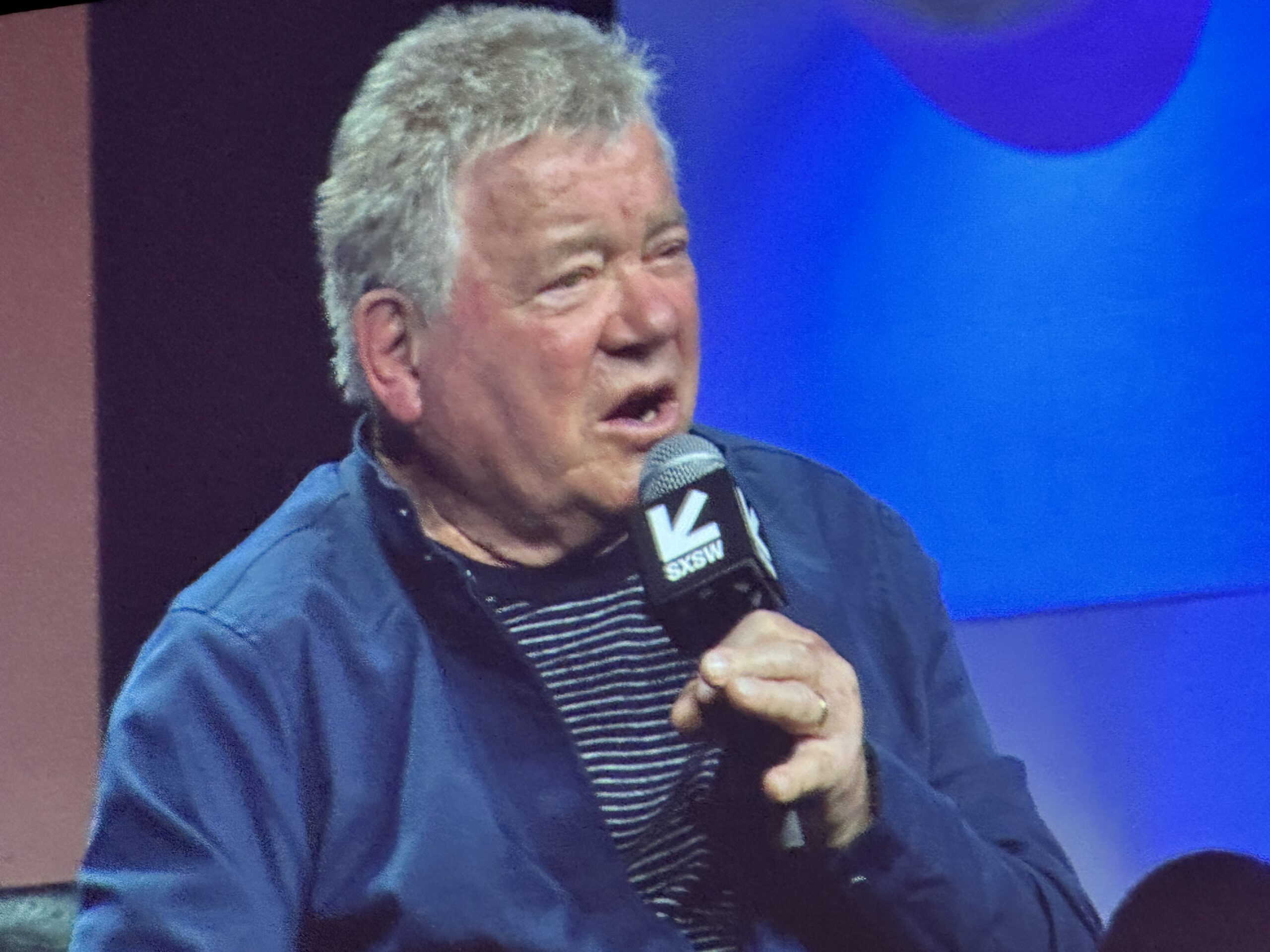Captain Kirk beamed down to Austin to attend SXSW. In addition to his appearance as a keynote speaker, he also was in attendance later that day for the premiere of a new documentary about his life. Of all the guests at SXSW, he was the only one greeted by a standing ovation whenever he entered and left the stage. Quite appropriate for America’s greatest acting icon.
Of course, he’s not even American! Yes, Shatner still has his Canadian passport.
He was supposed to be interviewed by Tim League, co-founder of Alamo Drafthouse, and while he was on stage with Shatner, League’s interviewing skills were so lacklustre he became an embarrassment to himself and the audience. Worse still, he became putty in the hands of the master. At one point he asked Shatner is he was still friends with fellow Canadian actor Christopher Plummer. “I am still friends with Chris. He’s dead,” shot back the 91-year-old Shatner, who is just as engaged and with-it as he was when commanding the Starship Enterprise in the 1960s.
Shatner reminisced about his entire life, from his boyhood in Montreal, Canada, to his time on Star Trek, to his recent flight to the edge of space on a rocketship built by Jeff Bezos.
“Shatner is a German name,” he said. “My father came to Canada when was 12 or 13 and brought al of his brothers and sisters from Germany over to Montreal. He worked very hard, he was very serious and expressed love not by saying ‘I love you’ but by working hard and providing for you. He loved me but it wasn’t a lot of emotional. So when he picked me up and said ‘My boy Bill’ I said to myself that will make a great song!”
Stratford Festival
When a group was starting a theatre in Stratford, Ontario Shatner was invited to join, but he turned it down. “And then they were a huge success, so the second year I went and was a member of the Stratford Shakespeare Company for three years.” During his time there, Plummer was playing Henry V, which is one of the larger roles. The director said I was going to understudy the role.”
Standing up to enact what he was talking about Shater continues. “It was repertory theatre so it meant that you would rehearse a play for a month or so before we opened the theatre officially. Then you would immediately start rehearsals on another play, so a month later you would open the second play, and third play. And then they would have understudy rehearsals after all that. So in the first week of opening the Shakespeare play I was understudying, Chris Plummer got ill and they came to me and said ‘Can you go on?’ And I said yes. I didn’t know the names of the actors, I didn’t know where to walk, but what I did know though,” Shatner said as he paced back and forth across the SXSW stage, “was, the actor’s Muse had been on my shoulder and it said to me ‘Learn the words.’ Though the understudy rehearsals were months away I studied in my little cell. I’d sit on the toilet and say “once more onto the breach!’ as I flushed the toilet! And so I went on. Chris later said I knew he was going to be successful because everywhere I stood he sat and everywhere I sat he stood. He didn’t realise I didn’t know where I was going! So if I got tired I sat down.”
Shatner related that the play was written for Queen Elizabeth I by Shakespeare; it’s filled with lots of patriotic speeches. Finally, the whole thing ends and the coda of the play is with the French princess – it’s like a romantic comedy for a few moments. I got through the play but I couldn’t remember the next words for the coda. 2,600 people were all surrounding, so the guy over here who played my role, the brother of King Henry, had a photographic memory in rehearsal. So, I went over to him and I said to him ‘What do I say?’” He mumbled something Shatner could not understand so I walked back and the words came to me! The Muse came to me and I finished the play and the critics wrote very nice things about what I said.” The enthralled audience at SWSX gave this soliloquy a rousing reception. And quite a memory for something that happened in 1954! “I’ve got all this old material: just trotting it out,” he quipped to great laughter.
Star Trek
Shatner recalled the unique circumstances that led to his role as Capt. Kirk (Star Trek first aired in Canada in Sept. 1966, a few days before the American premiere). “They made a pilot with Jeffrey Hunter, a good-looking guy who was quite a name. They sold the concept to NBC and they made an hour-long film and presented it to NBC. Then there is that moment when the Gods (in this case, NBC executives) decide to buy or not to buy’ Riffing off the famous line from Hamlet, Shatner then raised his voice: “To Buy or Not to Buy. That is the question! And they said no, we’re not going to buy because we don’t like it. But we like the idea: rewrite, recast and we’ll take another look at it. I’ve never heard of that happening before or since. So, they went around looking for a new captain. I was in New York and then said ‘Can you come and see the pilot?’ so I went and I auditioned them by looking at the pilot. I said that’s really good, why didn’t they buy it? They (the actors in the pilot) were a little pompous. I added a little lightness I think , and then it sold.”
League foolishly said Star Trek was a failure, which gave Shatner the opportunity to refute such nonsense. “It was a good show and it had some wonderful stories. Great ideas were given to us by many great science fiction writers such as Isaac Asimov.”
Education
Shatner had a lot to say about the current state of education. “They need to be inspired. Something is missing about the excitement of learning which is perhaps more exciting than anything. Acquiring knowledge that nobody else knows or that somebody else knows that you learned is enormously exciting. I read a lot of books. The discovery that plants and trees communicate was a profound astonishment to me. Trees use the mycelium of fungi for electrochemical signals (a wire, in effect) that they send to other trees. So there’s a Mother tree and a baby tree. It’s now established science fact. It’s an exact replica of the electrochemical signals in the human brain.” [The mycelial network was discussed by its chief proponent, Dr Paul Stamets, at SXSW; his talk is the subject of a separate story in SunNewsAustin]
Shatner emphasized one word: Science. “It can be so exciting in the discovery of stuff all around us, and all around us are things we don’t know anything about!”
He has some fantastic advice for the upcoming generation. “It’s all lying in front of us – the science is so exciting that I can’t understand who some kid is wondering ‘I don’t know what to do.’ GO BE A SCIENTIST,” Shatner shouted. “SAVE THE WORLD!”
See my coverage of Dr. Stamets and the mycelial network here:
Photo by C. Cunningham

